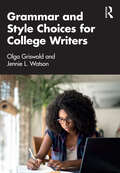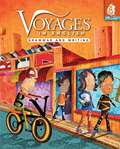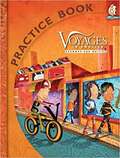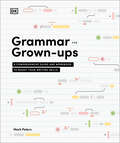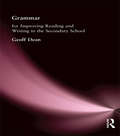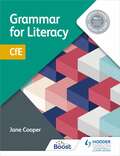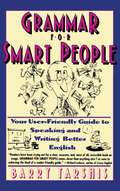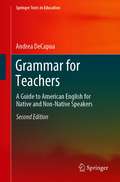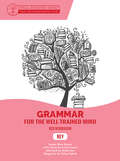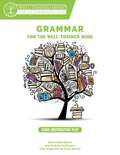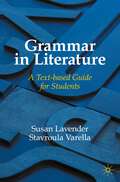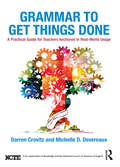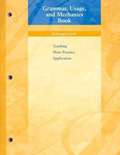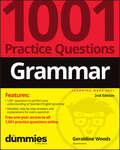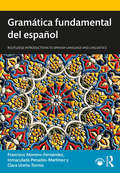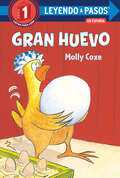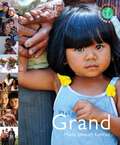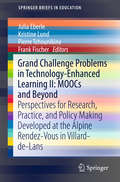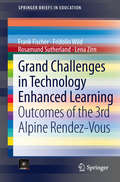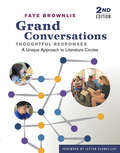- Table View
- List View
Grammar and Composition III
by James A. ChapmanStrengthen your grammar and writing skills with Grammar and Composition III. Grammar and Composition III is a work-text with perforated tear-out pages that is organized by the progression of simple concepts to the more challenging ones. The daily lessons provided enforce grammar concepts such as active and passive verbs, punctuation, capitalization, parts of speech, paragraph unity, and more that your students will apply to their writing exercises and persuasive research paper. The newly included Improving Communication sections cover a variety of topics and focus on real-world situations such as writing business letters and memos where your students must apply conciseness, subordination, and word usage. Your students will also receive study tips and information for in-class assessments and standardized testing. Purchase this student book today and place an emphasis on exceptional writing and proper grammar.
Grammar and Style Choices for College Writers
by Olga Griswold Jennie L WatsonThis textbook provides a practical guide to grammar and style choices for college writers, giving students a basic vocabulary for thinking and talking about language use and enabling them to make purposeful choices in their writing. Each section includes a short overview of a grammatical topic accompanied by exercises for raising the students’ awareness of and skills in using specific grammatical structures. It focuses on the practical and rhetorical functions of grammatical structures as they are used in expository and analytic writing, rather than on de-contextualized grammatical rules. Students will develop a repertoire of grammatical choices and understand the strategic reasons for making these choices in their writing for various audiences. It particularly attends to the structures that present the most difficulty for college students from multilingual communities and communities where a non-standard dialect of English is used on a daily basis. This textbook can be used as a core textbook for grammar course as well as a supplementary text for composition courses. It is also suitable for courses tailored to multilingual, advanced non-native, or non-standard speakers of English.
Grammar and Writing (Voyages in English 2011 #8)
by Patricia Healey Irene Kervick Adrienne Saybolt Ihm Sisters Anne B. McGuireThe new 2011 edition of Voyages in English: Grammar and Writing is the result of decades of research and practice by experts in the field of grammar and writing. Responding to the needs of teachers and students, this new edition provides ample opportunities for practice and review to ensure mastery and improved performance on standardized tests. <p>Grade 8
Grammar and Writing 6
by Christie Curtis Mary HakeWelcome to a language arts program designed for easy reading and instruction. This program consists of a series of daily lessons, review sets, and tests that are carefully sequenced to develop a variety of skills and concepts.
Grammar and Writing Grade 8 Practice Book (Voyages in English 2011)
by Patricia Healey Irene Kervick Adrienne Saybolt Ihm Sisters Anne B. McGuireThe new 2011 edition of Voyages in English: Grammar and Writing is the result of decades of research and practice by experts in the field of grammar and writing. Responding to the needs of teachers and students, this new edition provides ample opportunities for practice and review to ensure mastery and improved performance on standardized tests. <P><P> Voyages in English 2011 Enables children to master grammar through direct instruction, rigorous practice, written application, and ongoing assessment. Provides master and novice teachers with support and straightforward, practical lesson plans that can be presented with confidence. Guides children to experience, explore, and improve their writing through the in-depth study of unique writing genres, writing-skill lessons, and the implementation of the writing process. Provides children and teachers with opportunities to use technology as a means to learn, assess, apply new skills, and communicate outside of the school setting. Gives children the speaking and writing practice and tools they need to communicate with clarity, accuracy, and ease. New 2011 Features We’ve taken the best of the past and incorporated learning tools for today’s students and the world they live in. <P><P> More exercises in all components offer additional opportunities for review and practice. Daily Maintenance offers quick, daily practice for grammar concepts previously taught to ensure mastery of skills. Improved assessments offer more thorough testing of topics. Grammar and writing assessments are not integrated, providing more flexibility for teachers. ExamView® Assessment Suite Test Generator CD allows for 25% more testing questions and flexibility in creating individualized tests. Integration opportunities are included in the lessons to naturally show the relationship between grammar and writing. Tech Tips and technology opportunities allow teachers to incorporate technology into lesson plans and homework assignments. Online resources provide additional support for teachers and additional practice for students.
Grammar for Grown-Ups: A Comprehensive Guide and Workbook to Boost Your Writing Skills
by Mark PetersIt&’s never too late to brush up on your writing skills!Writing is a daily part of adult life, but many people are uncertain about basic rules and conventions. Do I need a comma before this clause? What exactly is a prepositional phrase? Is it ever necessary to use brackets? (Answer: Rarely, if ever.) With clear, no-nonsense explanations and examples, Grammar for Grown-ups makes learning the finer points of the English language easy. This comprehensive guide covers everything you need to know for clear and professional communication, including the mechanics of writing, the parts of speech, and proper punctuation and capitalization, as well as the most common errors—and how to avoid and fix them. Each lesson includes a practice exercise to reinforce learning.Master the basics—clear coverage of grammar rules and conventions, including the parts of speech and sentence structureFine-tune the mechanics—how to use punctuation effectively and accuratelyWrite with style—strategies to make your writing clear, compelling, consistent, and concisePractice makes perfect—exercise component for each lesson to reinforce learning
Grammar for Improving Writing and Reading in Secondary School
by Geoff DeanThis practical book is chiefly intended to help English teachers tackle an area of the new English programme that causes anxiety and about which a large proportion are still uncertain: grammar. Grammar has been an uncertain classroom topic for many years; taught often as a duty, without real progression. In this book, the latest knowledge about grammar is treated as a central component of the meaning making process, in both reading and writing. Pupils can become better readers and write with greater confidence and control as a result of using this approach to grammar. Teachers of other subjects may also benefit from knowing how to integrate some grammatical teaching into the textual interactions of their lessons.
Grammar for Literacy: CfE
by Jane CooperSyllabus: CfE (Curriculum for Excellence, from Education Scotland) and SQALevel: BGE (S1-S3) and Senior Phase (National 4/5)Subject: LiteracyGrammar matters. Understand how to use and structure language correctly to make your meaning clear.Learn about parts of speech, punctuation, sentences, paragraphs and spelling as you are guided through simple explanations, strategies, progressive activities and revision tasks.Grammar for Literacy equips pupils with the building blocks for success in exams, coursework and adult life, and facilitates literacy development across the curriculum.> Understand the essentials. Key concepts that pupils need to remember are introduced in 'explanation' boxes.> Put theory into practice. 'Building', 'Strengthening' and 'Extending' tasks enable pupils to apply their knowledge and skills, through a mix of solo and group work.> Check and consolidate. 'Bringing it all together' revision tasks at the end of each chapter can be used flexibly for classwork, homework or assessment.> See the big picture. 'Crossover' boxes make links to prior and future learning, cementing pupils' knowledge and skills.> Avoid common errors. 'Mistake' boxes contain examples and tips to ensure that pupils get it right in their own writing."I wrote this book because it was the one that I wanted to use in school when I was a teacher, but it didn't exist."Jane Cooper
Grammar for Literacy: CfE
by Jane CooperSyllabus: CfE (Curriculum for Excellence, from Education Scotland) and SQALevel: BGE (S1-S3) and Senior Phase (National 4/5)Subject: LiteracyGrammar matters. Understand how to use and structure language correctly to make your meaning clear.Learn about parts of speech, punctuation, sentences, paragraphs and spelling as you are guided through simple explanations, strategies, progressive activities and revision tasks.Grammar for Literacy equips pupils with the building blocks for success in exams, coursework and adult life, and facilitates literacy development across the curriculum.> Understand the essentials. Key concepts that pupils need to remember are introduced in 'explanation' boxes.> Put theory into practice. 'Building', 'Strengthening' and 'Extending' tasks enable pupils to apply their knowledge and skills, through a mix of solo and group work.> Check and consolidate. 'Bringing it all together' revision tasks at the end of each chapter can be used flexibly for classwork, homework or assessment.> See the big picture. 'Crossover' boxes make links to prior and future learning, cementing pupils' knowledge and skills.> Avoid common errors. 'Mistake' boxes contain examples and tips to ensure that pupils get it right in their own writing."I wrote this book because it was the one that I wanted to use in school when I was a teacher, but it didn't exist."Jane Cooper
Grammar for Smart People
by Barry TarshisGood grammar is essential for effective communication. Yet many of us are plagued by the same nagging question: If I'm so smart why does grammar make me feel so dumb? Grammar For Smart People can help. Here at last, is a lively, user-friendly guide that zeroes in on the areas that give everyone the most trouble, and it does it with an advantage most grammar books lack - a light touch. You won't feel as though you're back in the fifth grade, diagramming sentences and struggling with a grammar textbook filled with dull, unbreakable rules.
Grammar for Smart People
by TarshisGood grammar is essential for effective communication. Yet many of us are plagued by the same nagging question: If I'm so smart why does grammar make me feel so dumb? Grammar For Smart People can help. Here at last, is a lively, user-friendly guide that zeroes in on the areas that give everyone the most trouble, and it does it with an advantage most grammar books lack - a light touch. You won't feel as though you're back in the fifth grade, diagramming sentences and struggling with a grammar textbook filled with dull, unbreakable rules.
Grammar for Teachers: A Guide to American English for Native and Non-Native Speakers (Springer Texts in Education)
by Andrea DeCapuaUpdated and revised with more examples and expanded discussions, this second edition continues the aim of providing teachers with a solid understanding of the use and function of grammatical structures in American English. The book avoids jargon and presents essential grammatical structures clearly and concisely. Dr. DeCapua approaches grammar from a descriptive rather than a prescriptive standpoint, discussing differences between formal and informal language, and spoken and written English. The text draws examples from a wide variety of authentic materials to illustrate grammatical concepts. The many activities throughout the book engage users in exploring the different elements of grammar and in considering how these elements work together to form meaning. Users are encouraged to tap into their own, often subconscious, knowledge of grammar to consciously apply their knowledge to their own varied teaching settings. The text also emphasizes the importance of understanding grammar from the perspective of English language learners, an approach that allows teachers to better appreciate the difficulties these learners face. Specific areas of difficulties for learners of English are highlighted throughout.
Grammar for the Well-Trained Mind: A Complete Course For Young Writers, Aspiring Rhetoricians, And Anyone Else Who Needs To Understand How English Works (Grammar for the Well-Trained Mind #0)
by Susan Wise Bauer Amanda Saxon Dean Audrey Anderson Patty RebneThe Key to the Red Workbook gives clear, thoroughly-explained answers to all exercises in the Red Workbook, the second of four non-sequential books in the Grammar for the Well-Trained Mind series, providing detailed, well-designed exercises in the correct use of English grammar. The Key, along with the accompanying Red Workbook and the Core Instructor Text, make up Grammar for the Well-Trained Mind: a complete course that takes students from basic definitions (“A noun is the name of a person, place, thing, or idea”) through advanced sentence structure and analysis—all the grammar skills needed to write and speak with eloquence and confidence. This innovative program combines the three essential elements of language learning: understanding and memorizing rules (prescriptive teaching), repeated exposure to examples of how those rules are used (descriptive instruction), and practice using those rules in exercises and in writing (practical experience). Each year, parents and teachers go through the dialogue, rules, and examples in the Core Instructor Text; students follow along in the Workbook. This repetition solidifies the concepts, definitions, and examples in the student’s mind. There are four Student Workbooks, one for each year. Each Student Workbook contains the same rules and examples—but four completely different sets of exercises and assignments, allowing students to develop a wide-ranging knowledge of how the rules and examples are put to use in writing. Each Key to the Workbooks provides not only answers, but also explanations for the parent/instructor, and guidance as to when the answers might be ambiguous (as, in English, they often are). All of the rules covered, along with the repeated examples for each, are assembled for ongoing reference in the Comprehensive Handbook of Rules. This will become the student’s indispensable guide to writing through high school, into college and beyond. Step-by-step instruction takes students from the most basic concepts through advanced grammatical concepts such as modal and hortative verbs and multiple functions of noun clauses. Extensive diagramming exercises reinforce the rules and help technical and visual learners to understand and use the English language effectively. Each step of the diagramming process is illustrated and thoroughly explained to the student. Text for examples and exercises are drawn from great works of literature, as well as from well-written nonfiction texts in science, mathematics, and the social sciences. Regular review is built into each year of work. The Key accompanies the second of four non-sequential workbooks, each containing new exercises that allow students to practice and apply the grammar principles under study.
Grammar for the Well-Trained Mind: Core Instructor Text, Years 1 - 4
by Susan Wise Bauer Audrey AndersonTeach English grammar thoroughly, effectively, and with confidence―no matter what your background or experience! The central teaching text in a four-year grammar program that gives students a soup-to-nuts grasp of the English language, Grammar for the Well-Trained Mind: Core Instructor Text contains all teaching scripts and examples for a full course in English grammar and mechanics. <p><p>Grammar for the Well-Trained Mind takes students from basic definitions (“A noun is the name of a person, place, thing, or idea”) through advanced sentence structure and analysis―all the grammar skills needed to write and speak with eloquence and confidence. This innovative program combines the three essential elements of language learning: understanding and memorizing rules (prescriptive teaching), repeated exposure to examples of how those rules are used (descriptive instruction), and practice using those rules in exercises and in writing (practical experience). Each year, parents and teachers go through the dialogue, rules, and examples in the Core Instructor Text; students follow along in a Workbook. This repetition solidifies the concepts, definitions, and examples in the student’s mind. <p><p>There are four Workbooks, one for each year. Each Workbook contains the same rules and examples―but four completely different sets of exercises and assignments, allowing students to develop a wide-ranging knowledge of how the rules and examples are put to use in writing. Each Workbook comes with its own Key, providing not only answers, but also explanations for the parent/instructor, and guidance as to when the answers might be ambiguous (as, in English, they often are). All of the rules covered, along with the repeated examples for each, are assembled for ongoing reference in the Comprehensive Handbook of Rules. This will become the student’s indispensable guide to writing through high school, into college and beyond. The Core Instructor Text provides not only rules and examples, but scripted dialogue that makes it possible for any parent or teacher to use the program effectively, along with instructor notes that thoroughly explain ambiguities and difficulties. Scripted lessons make it possible for any parent or teacher to use the program effectively. <p><p>Step-by-step instruction takes students from the most basic concepts through advanced grammatical concepts such as modal and hortative verbs and multiple functions of noun clauses. Extensive diagramming exercises reinforce the rules and help technical and visual learners to understand and use the English language effectively. All diagrams are thoroughly explained to the instructor/parent. Text for examples and exercises are drawn from great works of literature, as well as from well-written nonfiction texts in science, mathematics, and the social sciences. Regular review is built into each year of work. Core Instructor Text is designed to be used effectively with students from fifth grade through high school, regardless of background. The program is easily customizable to each student’s strengths and weaknesses.
Grammar in Literature: A Text-based Guide for Students
by Susan Lavender Stavroula VarellaThis textbook familiarizes students with grammatical concepts of the English language and develops skills to apply grammar to creative writing and the study of literature. Students take an interactive 'learn-by-doing' approach to the mechanics of language and explore the creative uses of grammar. Experimenting with their own linguistic and creative skills, they come to appreciate the importance of language not only as a means of communication but also as an essential part of creative practice and literary composition. This applied approach to learning about grammar will be a valuable resource for students of English Literature and Creative Writing who may already be good users of grammar but not fully aware of its significance for communication and creativity.
Grammar to Get Things Done: A Practical Guide for Teachers Anchored in Real-World Usage
by Michelle D. Devereaux Darren CrovitzCO-PUBLISHED BY ROUTLEDGE AND THE NATIONAL COUNCIL OF TEACHERS OF ENGLISH Grammar to Get Things Done offers a fresh lens on grammar and grammar instruction, designed for middle and secondary pre-service and in-service English teachers. It shows how form, function, and use can help teachers move away from decontextualized grammar instruction (such as worksheets and exercises emphasizing rule-following and memorizing conventional definitions) and begin considering grammar in applied contexts of everyday use. Modules (organized by units) succinctly explain common grammatical concepts. These modules help English teachers gain confidence in their own understanding while positioning grammar instruction as an opportunity to discuss, analyze, and produce language for real purposes in the world. An important feature of the text is attention to both the history of and current attitudes about grammar through a sociocultural lens, with ideas for teachers to bring discussions of language-as-power into their own classrooms.
Grammar, Spelling & Vocabulary Activity Book (Benchmark Advance)
by Benchmark EducationGrade 5 Grammar, Spelling & Vocabulary Activity Book in the California Edition of Benchmark Advance Series.
Grammar: 1001 Practice Questions For Dummies (+ Free Online Practice)
by Geraldine WoodsLearn to dot your I’s and cross your T’s with this hands-on grammar practice The rules of grammar can seem abstract and confusing. But putting them into practice will help you understand and retain grammatical conventions. In Grammar: 1001 Practice Questions For Dummies, you’ll get the step-by-step and hands-on experience you need to improve your conjugations, gerund use, punctuation, and more. Each practice question includes detailed explanations and solutions available both in the book and online. The book also includes: Intuitive questions on everything from Oxford commas to verb tense Free, one-year access to all 1,001 practice questions online, and the ability to create customized quizzes and study sessions Detailed explanations for every question to help build your understandingIdeal for self-paced learning and as a companion for students in grammar and English classes in high school and college, Grammar: 1001 Practice Questions For Dummies (+ Free Online Practice) is a must-have resource to improve your written and spoken English communication. Grammar: 1001 Practice Questions For Dummies (9781119883746) was previously published as 1,001 Grammar Practice Questions For Dummies (9781118745014). While this version features a new Dummies cover and design, the content is the same as the prior release and should not be considered a new or updated product.
Gramática fundamental del español
by Francisco Moreno-Fernández Inmaculada Penadés-Martínez Clara Ureña-TormoGramática fundamental del español abarca una amplia gama de temas relacionados con la morfología, la sintaxis y la escritura del español. Usando ejemplos contextualizados y atendiendo a la dimensión cognitiva, esta gramática presenta diferentes maneras de entender numerosos aspectos básicos del uso y el significado de la gramática, incluyendo: frases, cláusulas y oraciones clases de palabras y tipos de oraciones gramática de la palabra construcción y análisis de oraciones gramática y escritura Esta obra incluye información gramatical sobre las variedades más generales del español. También proporciona un amplio conjunto de ejercicios, las soluciones a los ejercicios y un índice de materias y términos gramaticales. Esta gramática es una lectura clave para los estudiantes de español y de estudios hispánicos entre los niveles intermedio-bajo y avanzado-alto de ACTFL o bien entre los niveles B1 y C2, si se sigue el CEFR.
Gran huevo (LEYENDO A PASOS (Step into Reading))
by Molly CoxeA Spanish edition of the Step 1 early reader about a mama hen and big, heavy, mysterious egg!One morning, Hen wakes up and finds a gigantic egg in her nest. This isn't her egg! Here's a hint, Hen—it doesn't belong to that wily Fox, either!Step 1 Readers feature big type and easy words for children who know the alphabet and are eager to begin reading. Rhyme and rhythmic text paired with picture clues help children decode the story. LEYENDO A PASOS is a Spanish-language line of Step into Reading.
Grand (Early Reader #3)
by Marla Stewart KonradA picture book collaboration with World Vision that celebrates life the world over!This delightful series is the result of the collaboration between Tundra Books and World Vision Canada to bring an array of exceptional photos from around the world to very young children. Each book centers on a universal theme, familiar by its very nature, yet new due to faraway settings and ethnic, cultural, and socio-economic diversity. Each remarkable photo essay will foster discussion, observation, and many smiles as children compare and contrast their own experience to that of others. Watch for further books in this series.
Grand Challenge Problems in Technology-Enhanced Learning II: MOOCs and Beyond
by Frank Fischer Julia Eberle Kristine Lund Pierre TchounikineThis book reports on the proceedings at the STELLAR Alpine Rendez-Vous 2013, presenting strategies in handling challenges that arise when using technology-enhanced learning (TEL). With insightful contributions from leading teachers, practitioners, researchers and policy makers, this volume will inspire everyone interested in TEL in their future projects. This book continues the influential work of the STELLAR network which was funded by the European Commission to structure the research area of technology-enhanced learning and continues to the work on the previously developed research vision. It has potential to become influential in Europe, North America and Asia.
Grand Challenges in Technology Enhanced Learning
by Frank Fischer Fridolin Wild Rosamund Sutherland Lena ZirnThis book presents a key piece of the vision and strategy developed in STELLAR. It sets out a new mid-term agenda by defining Grand Challenges for research and development in technology-enhanced learning. Other than mere technology prizes, STELLAR Grand Challenges deal with problems at the interface of social and technical sciences. They pose problems that can be solved only in interdisciplinary collaboration. The descriptions of the Grand Challenge Problems were sent out to a number of stakeholders from industry, academia, and policy-making who responded with insightful, creative and critical comments bringing in their specific perspectives. This book will inspire everyone interested in TEL and its neighboring disciplines in their future projects. All of the listed problems, first hints with respect to the approach, measurable success indicators and funding sources are outlined. The challenges focus on what noted experts regard as important upcoming, pending, and innovative fields of research, the solution of which is within reach in a timeframe of a mere 2 to 15 years of work.
Grand Conversations, Thoughtful Responses: A Unique Approach to Literature Circles
by Faye BrownlieGrand Conversations, Thoughtful Responses is built upon the premise that all students can become active, independent, thoughtful readers. The structures and strategies in this book are proven to help students develop confidence and competence in their reading. Student engagement with text soars through participation in grand conversations with peers and reflecting on reading with thoughtful, written responses. This unique approach includes:student choice in booksstudents reading at their own pace, thus creating flexible groupsliterature circles where students discuss the shared text they are readingstrategies for teaching written responsestrategies for co-creating assessment criteriaadditional activities to develop and deepen comprehensionbook listsThis new edition has been expanded to include examples and book lists for grades K to 12.

